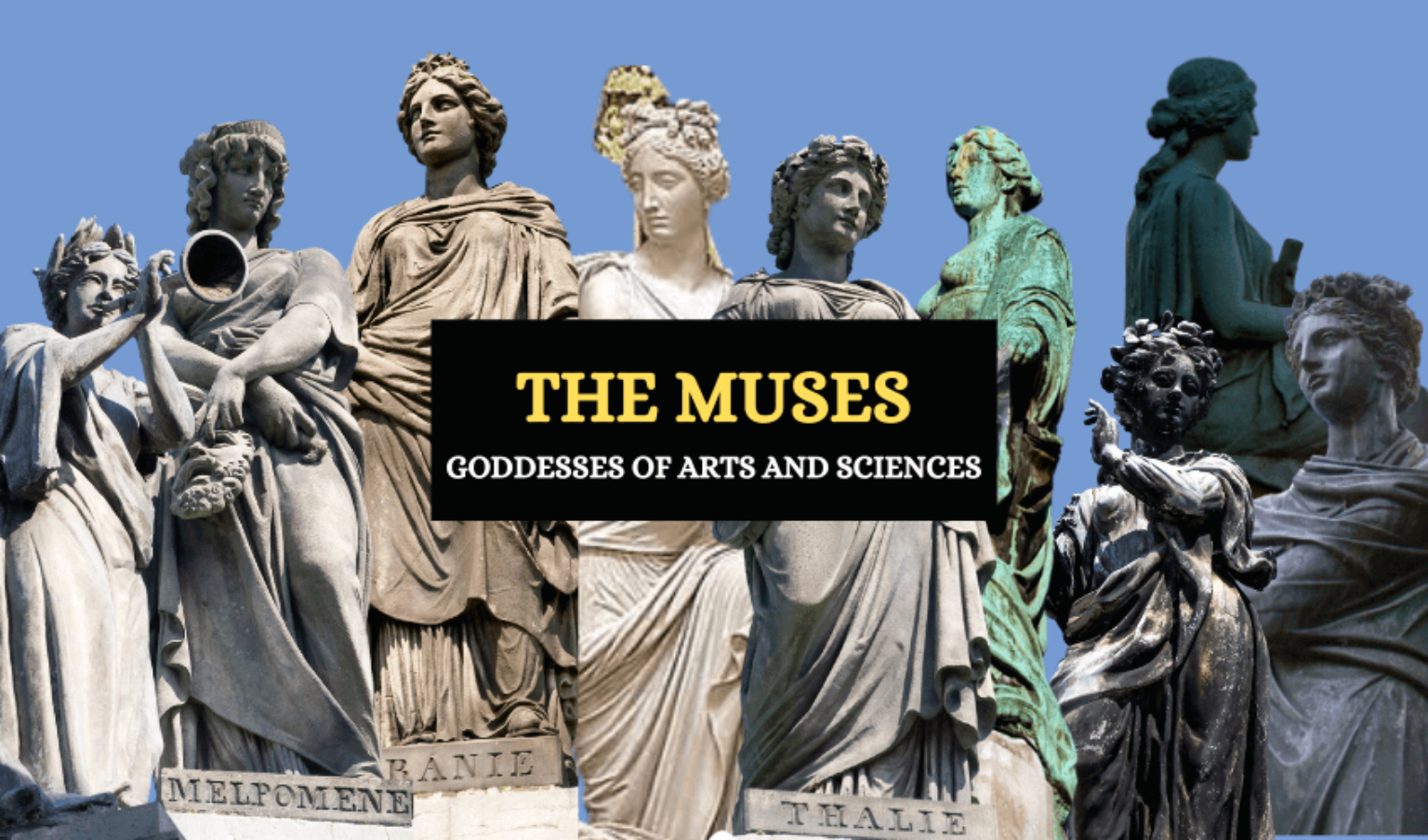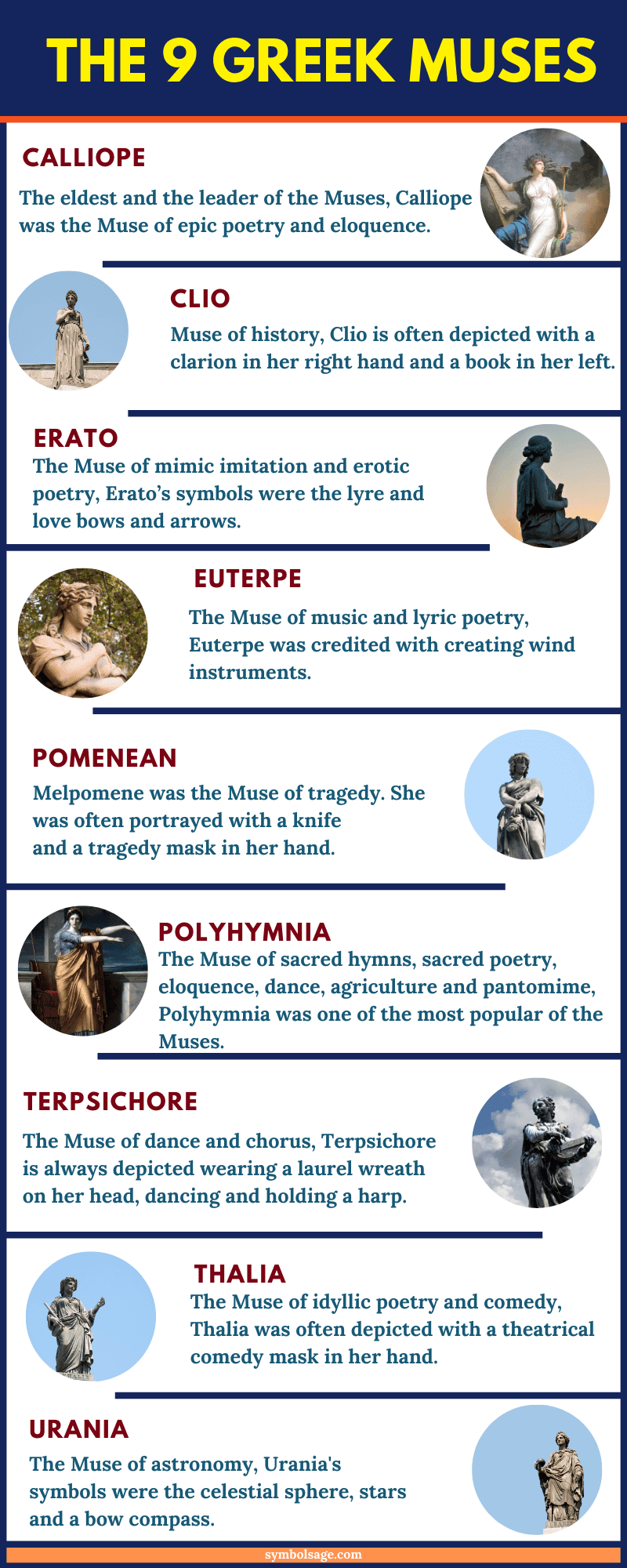Muses Symbols The Nine In Greek Mythology Symbol Sage
Her symbol is a veil which implies the traits of a virgin priestess. Terpsichore has also been mentioned in the orphic hyms and the works of diodorus siculus. She is and also associated with meditation and this is reflected by depictions of her leaning on a column apparently in deep thought:
The Nine Muses in Greek Mythology Symbol Sage
Names of the 9 muses: The muses gifted him a laurel staff which is considered a symbol of poetic authority, and hesiod subsequently dedicated the entire first section of theogony to them. The nine muses in greek mythology and legends:
Names of the nine muses in greek mythology
The gifts, appearances and symbols of the muses. There were nine muses, each with her own talents and attributes. Here are descriptions of each muse, including what they represented, some of their physical descriptions and symbolic items. Calliope was the chief of the nine muses and the patron of poetry.
She was the mother or orpheus. The muses gifts, appearances, and symbols. There were nine muses, all with their own unique talents and attributes. Here are descriptions of each muse, including what they represented, some of their physical descriptions, and symbolic items.

Calliope was the chief of the nine muses and the patron of poetry.
She was the mother or orpheus. The muses are the daughters of zeus, the king of the gods, and mnemosyne, the goddess of memory. Each of the nine muses is associated with a different domain: The muse of epic poetry.
Her symbols are a writing tablet and stylus. Her symbol is usually a scroll or a set of tablets. Her symbol is the lyre. She is often seen wearing a crown of roses.

Her symbol is the flute.
She is credited with the invention of the flute. She was the mother of rhosus who was killed in at troy. Her symbol is the tragic mask. He asked the muses to help him tell the stories of the iliad and odyssey and the muses became symbols of inspiration and artistic creation.
Below, world history edu presents the origin story, symbols and meaning of the nine muses in ancient greek religion. But first, here is a quick look at their origin story. According to ancient greek poet hesiod, the muses are the children of zeus and mnemosyne. Zeus is the king of the greek olympians, while mnemosyne is

Erato is regarded as one of the nine greek muses, the minor goddesses responsible for inspiring the ancient greeks to excel in the arts and sciences.
Erato was the muse of erotic poetry and mimic imitation. Musical symbols are marks and symbols in musical notation that indicate various aspects of how a piece of music is to be performed. There are symbols to communicate information about many musical elements, including pitch, duration, dynamics, or articulation of musical notes; Tempo, metre, form (e.g., whether sections are repeated), and details about specific playing techniques (e.g., which
All nine of the muses are said to be unmarried but they often gave birth to famous characters who appear in various stories. Hesiod is responsible for writing the most about the nine muses, and his versions of their stories are the most widely accepted. For instance, the names for the nine muses, included euterpe. Urania, also called ourania, was one of the nine muses, the daughter of zeus, and his wife mnemosyne, the goddess of memory.she was the muse of astronomy, and is often depicted with a rod in one hand and a celestial globe in her other hand.

Pausanias, description of greece 9.
Jones) (greek travelogue c2nd a.d.) : As you go along the straight road to the grove [of the mousai (muses) on mount helikon (helicon) in boiotia] is a portrait of eupheme (well spoken) carved in relief on a stone. Polyhymnia was one of the nine muses, the ancient greek goddesses of music, song and dance. In the classical era, when the muses were assigned specific artistic and literary spheres, polyhymnia was named muse of religious hymns and portrayed as a woman in a pensive or meditative pose.
The muses as symbols of inspiration and creativity. The muses serve as archetypes of inspiration, encouraging artists to explore their creativity and express their innermost thoughts through various forms of art. They personify the ethereal nature of artistic creation, making them central figures in the world of creativity. In ancient greek religion and mythology, the muses (ancient greek:
Múses) were the inspirational goddesses of literature, science, and the arts.
The muses were credited with inspiring some of the greatest art, poetry and music created by mortal men and women throughout history. As minor goddesses of the greek pantheon, they hardly ever featured in their own myths individually. The muses' symbols were the lyre, the scrolls, the globe, the writing tablet, the comic and tragic mask and the flute. Each muse has a unique set of symbols that reflect her domain, making them an essential part of the cultural heritage of the ancient world.
This article will explore the origins, meanings, and significance of the symbols of the muses. This circular mosaic is decorated with the names and symbols of apollo, mnemosyne and the nine muses. Modern interpretations of the muses continue to resonate in contemporary culture. Artists, writers, and creators frequently refer to the muses as symbols of inspiration, seeking their guidance in various forms of expression.
The idea of “finding one’s muse” has become a common phrase, representing the search for creative motivation.
The muses were also central to roman education, serving as symbols of the liberal arts. Philosophers and educators sought to emulate the muses’ inspiration in their teachings, leading to a rich cultural legacy that would influence future generations. Polyhymnia was the youngest of the nine muses, who were the goddesses of science and the arts. She was the muse of poetry, music and dance.
As a group they were known as the younger muses. They turned mount pierus into one of their homes and had their own sphere of influence in the arts. Because mnemosyne was the mother of the younger muses, she’s often confused with mnema, a greek goddess who was one of the elder muses. Since mnema was also a goddess of memory, the two were
In contemporary culture, the muses continue to inspire various media, including film, literature, and music.
They serve as symbols of creativity and the human pursuit of excellence in artistic expression. The muses and their modern interpretations. In today’s creative fields, the muses remain relevant as symbols of inspiration and These attributes or symbols are not exclusive to the muses, as they can also be shared by other gods or goddesses who have similar domains or interests.
For example, apollo also plays the lyre, athena also holds a scroll, and hermes also holds a tablet⁷.